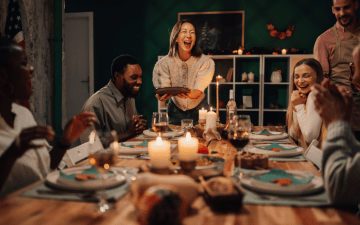Tips to Keep Your Children Safe at Halloween

Stay safe and spooky this Halloween with tips to protect your family from accidents and sugar overload.
Halloween can be one of the most fun days of the year, but it is also one of the least safe. More than 3,000 Halloween-related injuries happen each year in the U.S., including those from pumpkin carving accidents and falls from tripping on costumes. The risk of a child being hit by a car while walking more than doubles on Halloween.
We want to help you keep your family safe and healthy this Halloween. In this article, we are providing tips on how to do that, including ways to make costumes and decorations safer, and strategies for limiting your kids’ sugar intake during the holiday.
Safer Costumes
Creative Halloween costumes make the holiday fun and exciting for both kids and adults. However, a costume can be unsafe if it causes a child to fall or hinders their vision. When putting together Halloween costumes for your kids, be sure to take these steps to prevent injuries:
- The costume should fit well, and not be so big or long that it could get caught on something or your child could trip on it. Avoid oversized or high-heeled shoes that could lead to falls. Hats and wigs should fit so they can’t slip and block your child’s vision.
- Masks should not limit your child’s eyesight. Instead of a mask, consider using face paints or non-toxic makeup that won’t affect your child’s ability to see. Test face paints and makeup ahead of time to make sure there is no allergic reaction.
- Avoid dark-colored costumes that are difficult for drivers to see in the dark. If a dark-colored costume is worn, use reflective tape on it and trick-or-treat bags to make your child more visible to drivers.
- When purchasing a costume, look for one that is labeled as flame resistant or retardant. If you are making a costume, choose materials like nylon or polyester that won’t easily catch fire if they come into contact with a candle or other flame.
- Don’t allow any sharp edges or points on a costume, or props like a sword, that could cause injuries to your child or others. Items your child carries, such as a wand, should be flexible.
- Don’t use decorative contact lenses that have not been prescribed by an eye doctor, as they can cause serious eye problems.
Decorating Your Home
Part of the fun of Halloween is putting together spooky decorations for your home, like jack-o-lanterns and skeletons. It’s important to keep safety in mind when creating and setting up your decorations. Here are some things to do when preparing your home for Halloween:
- Small children shouldn’t be allowed to use sharp knives to carve pumpkins. You can get your kids involved by letting them clean out the inside of the pumpkin and draw a face on it, which you then carve for them.
- Jack-o-lanterns and other decorations should be placed so that trick-or-treaters won’t trip on them. To light a jack-o-lantern, use a flameless light source, such as a flashlight, glow stick, or LED candle.
- Take a close look at your front lawn, walkway, and porch to remove any tripping hazards. Put away things that may be laying around like water hoses, toys, and bikes.
- Turn on outdoor lights so that trick-or-treaters can more easily see your steps and walkway. Replace any burned out bulbs.
- Remove leaves from your walk and steps to prevent slipping and falls.
- No matter how well-behaved your dog or other pets are, having lots of strangers coming to the door on Halloween can make them forget their manners. Make sure your pets are restrained so that they can’t jump on or try to bite trick-or-treaters.
Going Trick-or-Treating
When it’s time for your ghouls and goblins to go off in search of Halloween treats, here are some things you can do to make sure their trick-or-treating remains injury-free:
- Kids under 12 should be accompanied by an adult.
- Children should know how to call 9-1-1 if they get lost or there is another problem. They should also know your home or mobile number so they can call you, if necessary.
- Plan a route with your kids and set a time when they should be home. Consider limiting trick-or-treating to your neighborhood and houses of people you know.
- Consider providing your children with a cell phone for the evening, if they don’t already have one, so you can stay in touch.
- Tell your kids about the importance of trick-or-treating in a group and staying together. If you only have one child going out, pair them up with neighbors’ children. Also instruct them to only visit houses with porch lights on, and to never go inside strangers’ homes or cars.
- Remind your kids that they should stay on the sidewalk, or if there is no sidewalk, to walk on the shoulder of the road facing oncoming traffic. When crossing a street, they should use a crosswalk and wait for traffic to stop before crossing.
- Give your kids flashlights that have fresh batteries or are fully charged. Glow sticks that can be worn as bracelets or necklaces will also help make them more visible to drivers.
- Talk with your kids about the danger of running from house to house, or across the street. Also teach them about the need to always look carefully where they are going and not be distracted by things like text messages.
Limiting Sugary Treats
All kids want to maximize their Halloween haul, and they can’t wait to dig into the tasty morsels. You can make the evening and the days that follow healthier by using these strategies:
- Make your kids a full meal before they go out trick-or-treating. This will reduce the temptation to snack on candy before returning home.
- When your kids get home, determine how much candy each received and keep track of it. Find a place to store it, other than their bedrooms.
- If you have very young children, go through Halloween bags and remove any choking hazards such as gum and hard candies.
- Only keep candy that is commercially wrapped and inspect each piece for signs of tampering. Throw out any candy that has torn packaging or holes. Make sure any homemade treats came from someone you know.
- If your child has a food allergy, check package labels to make sure the candy doesn’t have ingredients your child is allergic to.
- Talk with your kids about how the rest of their candy will be consumed. Set a limit on how many pieces per day, such as one or two, they can have.
- Don’t leave candy out for kids to eat whenever they want.
- Introduce your kids to the concept of eating in moderation, so that they won’t overdo it and their Halloween stash will last longer.
You won’t have to be scared about your children’s safety this Halloween, if you follow these steps to prevent injuries. We hope your Halloween is a safe and happy one!



